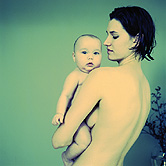
THURSDAY, April 18 (HealthDay News) — The best place for a crying baby is in its mother’s arms, researchers suggest.
When fretful babies are picked up and carried by their mothers they experience an automatic calming reaction, they said.
This evolutionary effect, seen in both mice and people, reflects a coordinated set of central, motor and cardiac regulations, according to the study, which was published April 18 in the journal Current Biology.
It also could help explain why calm babies start crying as soon as they are put down. This insight could help ease parents’ frustration and help prevent child abuse, the researchers said.
“From humans to mice, mammalian infants become calm and relaxed when they are carried by their mother,” Kumi Kuroda of the RIKEN Brain Science Institute in Saitama, Japan, said in a journal news release. “This infant response reduces the maternal burden of carrying and is beneficial for both the mother and the infant.”
When babies are in their mother’s arms, they have a greater chance for survival, the researchers said. Meanwhile, mothers prefer to have calm and relaxed babies. It’s a win-win for moms and their babies, the researchers said.
Kuroda noticed the same calming response among mice in her laboratory. “When I picked the pups up at the back skin very softly and swiftly as mouse mothers did, they immediately stopped moving and became compact. They appeared relaxed, but not totally floppy, and kept the limbs flexed,” she said. “This calming response in mice appeared similar to soothing by maternal carrying in human babies.”
In studying the response of human babies when carried by their mothers, the researchers found that their heart rates slowed immediately when they were picked up. They also stopped moving. Using tiny heart monitor electrodes, the same response was found among mice. The ultrasonic cries of baby mice stopped as well.
The study authors said certain areas of the brain and nervous system are essential to coordinating this response to being carried.
The findings are very relevant to parenting and may play a role in the development of strategies to prevent child abuse, the researchers said. Understanding crying from a baby’s perspective might ease their frustration, they said. When parents are less frustrated, child abuse may be less likely to occur.
“A scientific understanding of this infant response will save parents from misreading the restart of crying as the intention of the infant to control the parents, as some parenting theories — such as the ‘cry it out’ type of strategy — suggest,” Kuroda said. “Rather, this phenomenon should be interpreted as a natural consequence of the infant sensorimotor systems.”
More information
The American Academy of Pediatrics provides tips on how to respond to your baby’s cries.

